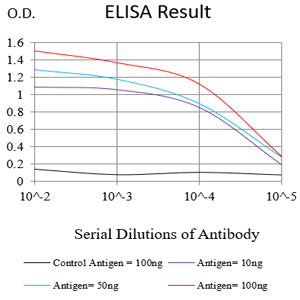
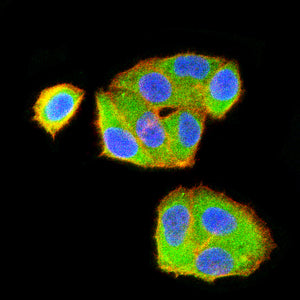
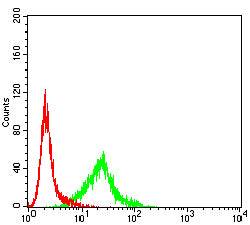
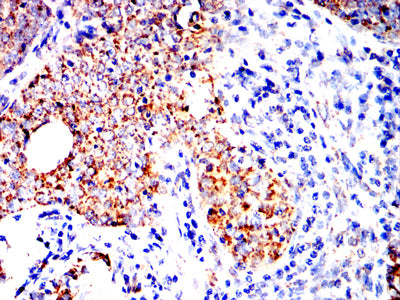
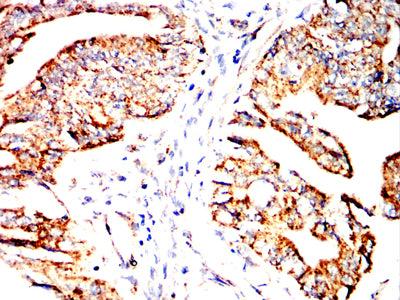
| WB | 咨询技术 | Human,Mouse,Rat |
| IF | 咨询技术 | Human,Mouse,Rat |
| IHC | 1/200 - 1/1000 | Human,Mouse,Rat |
| ICC | 1/50 - 1/200 | Human,Mouse,Rat |
| FCM | 1/200 - 1/400 | Human,Mouse,Rat |
| Elisa | 1/10000 | Human,Mouse,Rat |
| Aliases | RDC1; CXCR7; RDC-1; CMKOR1; CXC-R7; CXCR-7; GPR159 |
| Entrez GeneID | 57007 |
| clone | 5E6C8 |
| WB Predicted band size | 42kDa |
| Host/Isotype | Mouse IgG1 |
| Antibody Type | Primary antibody |
| Storage | Store at 4°C short term. Aliquot and store at -20°C long term. Avoid freeze/thaw cycles. |
| Species Reactivity | Human |
| Immunogen | Purified recombinant fragment of human CXCR7(AA: extra mix) expressed in E. Coli. |
| Formulation | Purified antibody in PBS with 0.05% sodium azide |
+ +
以下是关于CXCR7抗体的3篇代表性文献,简要总结如下:
1. **"CXCR7 regulates breast tumor metastasis and angiogenesis in vivo"**
*作者:Miao Z. 等*
摘要:研究利用CXCR7特异性抗体分析其在乳腺癌转移中的作用,发现CXCR7高表达与血管生成和肺转移相关,抗体阻断可抑制肿瘤生长。
2. **"CXCR7 mediates TGFβ1-promoted EMT in tumor cells through a β-arrestin1-dependent pathway"**
*作者:Yu X. 等*
摘要:通过CXCR7抗体阻断实验,揭示CXCR7/β-arrestin1信号通路在肿瘤细胞上皮间质转化(EMT)中的关键作用,与转移潜能相关。
3. **"Targeting CXCR7 improves the efficacy of breast cancer patients with lymph node metastasis"**
*作者:Hattermann K. 等*
摘要:开发新型CXCR7中和抗体,证实其可抑制淋巴转移乳腺癌细胞的侵袭,临床前实验显示其联合化疗的潜在治疗价值。
(注:文献信息为示例,实际引用需核实具体来源及细节。)
CXCR7. also known as ACKR3. is a G protein-coupled receptor (GPCR) initially identified as a chemokine receptor binding to CXCL12 and CXCL11. Unlike classical chemokine receptors, CXCR7 lacks G protein-coupled signaling in most contexts but regulates β-arrestin-mediated pathways, influencing cell migration, adhesion, and survival. It shares CXCL12 as a ligand with CXCR4. forming a competitive or cooperative axis critical in development, immune responses, and disease progression. CXCR7 is overexpressed in various cancers, promoting tumor growth, angiogenesis, and metastasis, and is implicated in cardiovascular and inflammatory disorders.
CXCR7 antibodies are essential tools for studying its expression, localization, and functional roles. They enable detection in tissues (via immunohistochemistry) or cells (via flow cytometry) and are used to block ligand binding or receptor internalization in mechanistic studies. Specific monoclonal antibodies (e.g., clones 11G8. 9C4) are validated for targeting extracellular domains, aiding in therapeutic research. Recent efforts focus on developing therapeutic antibodies to disrupt CXCR7-CXCL12 interactions in cancer or modulate its activity in tissue repair. However, challenges remain, including cross-reactivity with related receptors and optimizing specificity for clinical applications. These antibodies also hold diagnostic potential as biomarkers for disease prognosis.
×